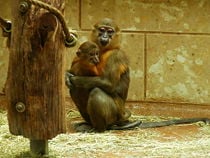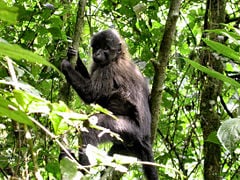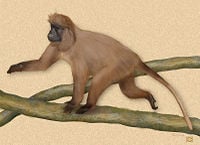Mangabey
| Mangabeys | ||||||||||
|---|---|---|---|---|---|---|---|---|---|---|
 Golden-bellied mangabey
| ||||||||||
| Scientific classification | ||||||||||
| ||||||||||
|
Mangabey is the common name for the various Old World monkeys comprising the genera Lophocebus ( crested mangabeys)m Cercocebus (white-eyelid mangabeys), and Rungwecebus (highland mangabey, Rungwecebus kipunji, also known as the kipunji). They belong to the same family (Cercopithecinae) and tribe (Papionini) as macaques, baboons, and mandrills.
Classification
Mangabeys are Old World monkeys (family Cercopithecidae), which, along with apes of the Old World, comprise one of the three major informal groups of the biological order Primates, the other two groups being prosimians and New World monkeys. Old World monkeys typically are characterized by close-set nostrils that are downward or forward facing, a tubular ear bone, and a tail, if present, that is never prehensile (adapted for grasping or holding).
Mangabeys comprise three genera within the Old World monkeys:
- FAMILY CERCOPITHECIDAE
- Subfamily Colobinae
- Subfamily Cercopithecinae
- Tribe Cercopithecini
- Tribe Papionini
- Genus Lophocebus - crested mangabeys
- Genus Rungwecebus - Highland Mangabey
- Genus Cercocebus - white-eyelid mangabeys
- Genus Macaca - macaques
- Genus Papio - baboons
- Genus Theropithecus - Gelada
- Genus Mandrillus - Drill and Mandrill
The three genera of mangabeys—Lophocebus, Rungwecebus, and Cercocebus—were once thought to be very closely related, so much so that all the species were in one genera. However, it is now understood that Lophocebus and Rungwecebus species are more closely related to the baboons in genus Papio, while the Cercocebus species are more closely related to the mandrill in genus Mandrillus. In 2006, the highland mangabey was moved from Lophocebus to a new genus, Rungwecebus, the first new primate genus in 83 years.
Crested mangabeys (Lophocebus)
The crested mangabeys are West-African Old World monkeys, belonging to the genus Lophocebus. They tend to have dark skin, eyelids that match their facial skin, and crests of hair on their heads. They are closely aligned to baboons (Papio) and have been called baboon-manabeys (Groves 2007). It is believed that they diverged from the baboons and the geladas (Theropithecus) only about 4 million years ago, in the mid-Pliocene (Groves 2007).
Currently, about six species are recognized (Groves 2007):
- Gray-cheeked mangabey, Lophocebus albigena
- Black crested mangabey, Lophocebus aterrimus
- Opdenbosch's mangabey, Lophocebus opdenboschi
- Uganda mangabey, Lophocebus ugandae
- Johnston's mangabey, Lophocebus johnstoni
- Osman Hill's mangabey, Lophocebus osmani
Originally, five subspecies were recognized, all placed within L. albigena. However, subsequent analysis led first to the upgrading of L. aterrimus and l. opdenboschi to species rank, and then the recognition of the other three subspecies as diagnosably distinct species; subsequent re-examination of field survey data also lead to the designation of a new species L. ugandae (Groves 2007; Tenywa 2007). Characters on the crest of the crown, cheek whiskers, and pelage in general can be used to recognize the differences in these species. For example, in the color of the mantle of elongated hair over the foreparts, the color in L. osmani is rusty brown, in L. albigena is is light gray (sometimes with faint straw tones), and in L. johnstoni it varies from a dark gray-brown to a very pale, whitish-gray to chocolate (Groves 2007). in L. osmani and L. albigena there is usually a black patch on the nape and withers (with this rare in L. johnstoni, and the underside is yellow-gray in L. osmani but noticeably lighter in L. johnstoni and L. albigena. In osmain the cheek-whiskers are long and bright gray or golden-white, while they are more creamy in L. albigena and light gray-brown to white in L. johnstoni.
Given the close similarity of these monkeys, a description of the gray-cheeked mangabey (Lophocebus albigena) will help to provide insights on crested mangabeys in general. Gray-cheeked mangabeys have very long, slender, somewhat prehensile tails, which can reach 55 to 100 centimeters in length, while the adults themselves measure between 40 and 72 centimeters in length and between 4 and 11 kilograms in weight (Davis 2002). They have slight sexual dimorphism with males 15% to 30% larger than females (Davis 2002).L. albigena is nearly completely arboreal, preferring to inhabit the middle and upper layers of the canopy (Davis 2002). They only come to ground occasionally for feeding, such as to raid cultivated fields (Davis 2002). The majority of time they feed on fruits, with nuts and [seed]]s also prominent in their diet (Davis 2002). Other food sources are flowers, leaves, and insects, as well as cultivated crops such as maize and sweet potatoes.
==Highland mangabey (Rungwecebus kipunji)
The highland mangabey (Rungwecebus kipunji) is a species of Old World monkey that lives in the highland forests of Tanzania. Also known as the kipunji, it is about three feet long and has long brown fur, which stands in tufts on the sides and top of its head. Its face and eyelids are uniformly black. The highland mangabey is arboreal in its habits. All the males of this mangabey species emit a loud call to coordinate spacing between different groups. The Kipunji has a unique call, described as a 'honk-bark', which distinguishes it from its close relatives the Grey-cheeked Mangabey and the Black Crested Mangabey, whose calls are described as 'whoop-gobbles'.
Perhaps fewer than 1,000 of the animals live in the highland Ndundulu Forest Reserve, an unprotected forest adjacent to Udzungwa Mountains National Park, and in a disjunct population 250 miles away on Mount Rungwe and in Kitulo National Park, which is adjacent to it. The forest at Rungwe is highly degraded, and fragmentation of the remaining forest threatens to split that population into three smaller populations. The Ndundulu forest is in better shape, but the population there is smaller. The monkey will likely be classified as a critically endangered species.
The Kipunji was independently discovered by researchers from the Wildlife Conservation Society (WCS), the University of Georgia (UGA) and Conservation International (CI), in December 2003 and July 2004, making it the first new African monkey species discovered since the Sun-tailed Monkey in 1984.[1] Originally assigned to the genus Lophocebus,[1] genetic and morphological tests showed that it is more closely related to the baboons (genus Papio) than to the other mangabeys in the genus Lophocebus and that the genus is diphyletic, meaning that species with differing genealogies have been mistakenly lumped together. Scientists have assigned it to a new genus, Rungwecebus, named after Mount Rungwe, where it is found.[2]
Rungwecebus is the first new monkey genus to be discovered since Allen's Swamp Monkey in 1923, according to researchers.[3]
White-eyelid mangabeys
The white-eyelid mangabeys are West-African Old World monkeys, belonging to the genus Cercocebus. They are characterized by their bare upper eye-lids which are lighter than their facial skin coloring, and the uniformly colored hairs of the fur.
Species
- Genus Cercocebus
- Sooty Mangabey, Cercocebus atys
- Collared Mangabey, Cercocebus torquatus
- Agile Mangabey, Cercocebus agilis
- Golden-bellied Mangabey, Cercocebus chrysogaster
- Tana River Mangabey, Cercocebus galeritus
- Sanje Mangabey, Cercocebus sanjei
ReferencesISBN links support NWE through referral fees
- ↑ 1.0 1.1 Jones, Trevor and Carolyn L. Ehardt, Thomas M. Butynski, Tim R. B. Davenport, Noah E. Mpunga, Sophy J. Machaga, Daniela W. De Luca (2005). The Highland Mangabey Lopocebus kipunji: A New Species of African Monkey. Science 308 (5725): 1161–1164.
- ↑ Davenport, Tim R. B. and William T. Stanley, Eric J. Sargis, Daniela W. De Luca, Noah E. Mpunga, Sophy J. Machaga, and Link E. Olson (2006). A New Genus of African Monkey, Rungwecebus: Morphology, Ecology, and Molecular Phylogenetics. Science 312: 1378.
- ↑ "Scientists Discover New Monkey Genus In Africa"
- Boomershine, L. and L. Olson. 2007. "Rungwecebus kipunji" (On-line), Animal Diversity Web. Accessed June 26, 2008 at http://animaldiversity.ummz.umich.edu/site/accounts/information/Rungwecebus_kipunji.html.
- Davis, S. 2002. "Lophocebus albigena" (On-line), Animal Diversity Web. Accessed June 26, 2008 at http://animaldiversity.ummz.umich.edu/site/accounts/information/Lophocebus_albigena.html.
- Groves, C. 2005. Order Primates. In D. E. Wilson and D. M. Reeder (eds.), Mammal Species of the World, 3rd edition. Johns Hopkins University Press. ISBN 0801882214.
- Groves, C. 2007. The endemic Uganda mangabey, Lophocebus ugandae, and other members of the albigena-group (Lophocebus). Primate Conservation 22. Retrieved June 27, 2008.
- Nguyen, K. 1999. "Cercocebus torquatus" (On-line), Animal Diversity Web. Accessed June 26, 2008 at http://animaldiversity.ummz.umich.edu/site/accounts/information/Cercocebus_torquatus.html.
- Tenywa, G. 2007. New monkey species in Mabira—expert. New Vision February 16, 2007. Retrieved June 27, 2008.
External links
- Primate Info Net Lophocebus Factsheets
- Primate Info Net Cercocebus Factsheets
- ARKive - images and movies of the highland mangabey (Lophocebus kipunji)
- BBC: New African monkey discovered
- BBC: New genus of African monkey found
- African monkey reshapes the tree of life
- New scientist: New monkey species discovered in Africa
- Press release from the Wildlife Conservation Society
- http://news.bbc.co.uk/1/hi/sci/tech/4759535.stm
- http://news.bbc.co.uk/player/nol/newsid_4760000/newsid_4762300/4762373.stm?bw=bb&mp=rm&news=1&bbcws=1
- http://www.wcs.org/international/Africa/Tanzania/highlandmangabey WCS profile of Highland Mangabey]
- National Science Foundation press release
- Highland Mangabey's honk-bark (in .WAV format)
- Video of Highland Mangabey (in MPEG format)
- ITIS Report: Lophocebus kipunji (Accessed September 28, 2005)
Credits
New World Encyclopedia writers and editors rewrote and completed the Wikipedia article in accordance with New World Encyclopedia standards. This article abides by terms of the Creative Commons CC-by-sa 3.0 License (CC-by-sa), which may be used and disseminated with proper attribution. Credit is due under the terms of this license that can reference both the New World Encyclopedia contributors and the selfless volunteer contributors of the Wikimedia Foundation. To cite this article click here for a list of acceptable citing formats.The history of earlier contributions by wikipedians is accessible to researchers here:
The history of this article since it was imported to New World Encyclopedia:
Note: Some restrictions may apply to use of individual images which are separately licensed.


